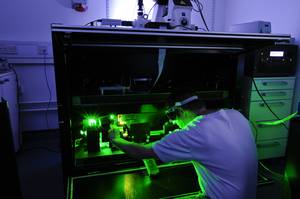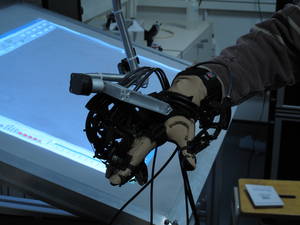Using a Laser as Tweezers
Interview with
Ben - Now one of the many new applications of lasers is in the building of tiny, tiny machines. A small device that builds a smaller device, and so on, down to atomic level was a dream of Nobel Prize winning physicist, Richard Feynman and he inspired many researchers to try and find a way. Now, when handling tiny objects, you need tiny tools, and lasers make very good tweezers. To find out how they work, I went to Bristol University and met Physicist, Dr. David Carberry.
David - The goal of our research was to follow Feynman's dream. So this is where you've got a large machine that makes a smaller machine, that makes a smaller machine, until eventually, you can control individual atoms. We're not quite near that stage yet. But we're at the stage where we can definitely build a microscopic machine. We're currently using a large machine that uses a focused laser beam to manipulate small particles around.
Ben - So in order to realize your dream, you need to be able to manipulate things on a tiny, tiny scale, and you're actually using light beams as if they were tweezers?
David - That's absolutely correct.
Ben - Surely, tweezers have to be something - somewhat more solid than light?
David - It really is a focused beam of light. Imagine you've got a glass sphere sitting in  front of you. If you shine a laser beam through that, it will bend towards the centre. This means there has been a change in momentum, which has to have been transferred to the glass sphere. In the case of the glass sphere that you can hold in your hand, the amount of momentum transfer, you can't detect, but in the case of something very small, around the size of a red blood cell, then this has a very large profound effect. It moves into the focus of the laser beam and this is an optical trap or an optical tweezer.
front of you. If you shine a laser beam through that, it will bend towards the centre. This means there has been a change in momentum, which has to have been transferred to the glass sphere. In the case of the glass sphere that you can hold in your hand, the amount of momentum transfer, you can't detect, but in the case of something very small, around the size of a red blood cell, then this has a very large profound effect. It moves into the focus of the laser beam and this is an optical trap or an optical tweezer.
Ben - So the system you have, the holographic optical tweezers, how do they work? Where do you start with that?
David - The simplest way is to have a laser beam that is passed straight into a microscope. It goes through a very high objective lens, so very high numerical aperture, very high magnification, then you form an optical trap if the laser is strong enough. You typically need around 50 milliwatts for the base optical trap. To give an indication of how strong the magnification needs to be, you've got a 100 times objective lens which focuses a 5 millimetre laser beam at a distance of about 100 microns or the thickness of one hair. It's very tightly focused. But this is absolutely required to form a sharp enough laser gradient to hold a particle at the laser focus.
Ben - So you can very tightly focus a laser which means that you can hold something in what you call an optical trap. But in order to construct things, surely you need to bring more than one thing together, so you'd need more than one laser?
David - That's right. But we don't strictly need more than one laser. If we use a hologram, we can break one laser beam up into several outgoing parts and we can control the pattern of the light that comes off that. So, as the laser reflects, it interferes with itself just like you'll see at the beach, the waves will interfere with each other, and this, we can then use to reconstruct several laser beams in the focus of our objective.
Ben - Well that sounds really incredible, but also very complicated. How on earth do you actually control it? How do you do the physical work of bringing two things together?
David - We've got a number of methods. The first one is a simple one. You've got a  couple of points on the screen with a mouse and you click on the optical trap you want and you move it closer to another optical trap. There's another one where we've got special gloves that you can put on, you can move your fingers closer together, and you can move this around the screen, and you can move the particles closer together. But our most recent thing, we've got a touch screen that we can touch with multiple fingers. Wherever we put our fingers, we form an optical trap, and we can manipulate this in real time, and we can start assembling, we can start whatever we choose to do.
couple of points on the screen with a mouse and you click on the optical trap you want and you move it closer to another optical trap. There's another one where we've got special gloves that you can put on, you can move your fingers closer together, and you can move this around the screen, and you can move the particles closer together. But our most recent thing, we've got a touch screen that we can touch with multiple fingers. Wherever we put our fingers, we form an optical trap, and we can manipulate this in real time, and we can start assembling, we can start whatever we choose to do.
Ben - Could I have a go? It sounds like something that you don't need much training for.
David - I can teach you all you need to know within 30 seconds using this multi-touch. Let's give it a shot.
Ben - At this point, David showed me into the laser room. The holographic assembler itself is housed in a large box as the lasers are powerful enough to cause permanent eye damage. On the top of the box is a microscope with a camera focused on the tiny glass beads that the laser can move. The feed from this camera is then fed through to a computer where you can interact with the beads in real time.
David - This is our multi-touch table where if you stick your finger on it, you will be able to manipulate the glass sphere that is sitting on the screen.
Ben - So does that mean that while I'm pressing on here and moving my finger around, I'm actually dragging around a tiny glass sphere over there on the microscope.
David - That's exactly correct.
Ben - And how big are these?
David - These are about 2 microns, so about a third the size of a red blood cell, but let's put this into perspective. One of these is 50 times smaller than the width of a human hair.
Ben - So these really are tiny. What's the next stage? What do you hope to develop next?
David - The next stage is to develop a few more applications. We're currently looking at two different projects. We're trying to make some nano tools. If we use a nano rod, with two of these glass spheres, we can stick it together and form a kind of pointy stick that we can poke very hard into another object. So we could start feeling the forces on a cell as we poke it.
Ben - And that would be able to tell us things like how strong the membrane of a cell is and I assume this is something that we've just never really been able to measure before.
David - We have been able to measure using the atomic force microscope, but that assumes that it's sitting on the surface and this isn't always the case. Sometimes you've got cells that are floating around in solution and you want to be able to test these in the natural environment, so you don't want to stick them down.
Ben - Let's see the videos of some of the things you have been able to build. What's this? It's very pretty and it seems to be a series of connected rings, almost like the Olympic logo over and over again.
David - That's right, but instead of being just rings, these are actually these glass spheres we've just been manipulating on the screen. In nature, if you start assembling these, or you leave it to gravity, they will form a close packed structure and you've probably all seen this with a pile of beer cans. You stack them all up and they all fit into each other's cavities. Now it's the same with all balls. You can set them the same sort of way, but what I've got on screen is I've deliberately omitted a particular line of these so if you've got your stack of cans, we've now deliberately taken out one particular line, and if we shine a laser beam through here with different frequencies, some laser light will get reflected, some will transmit through, and some will go round the corner, and this is a photonic crystal.
Ben - So because we have a gap in the middle of this collection of glass beads, you get some very particular interactions with light. What's this useful for?
David - In the past, we had something very similar with electronics and we ended up forming the transistor. Now this has gone on to revolutionise the electronics industry. We're hoping that a photonic switch like this will go on and revolutionise the next generation of device.
Ben - Dr. David Carberry from Bristol University on how optical tweezers can be used to build transistors for light and nano tools to study cells.









Comments
Add a comment